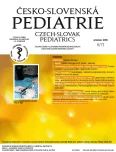The Family Eating and Activity Habits Questionnaire – Czech translation and verification questionnaire clarity
Authors:
I. Klimešová 1; J. Stelzer 2; L. Miklánková 3
Authors‘ workplace:
Katedra přírodních věd v kinantropologii, Fakulta tělesné kultury UP, Olomouc
1; Department of Kinesiology and PE, Dewar College of Education and Human Services, Valdosta State University, Valdosta, GA, USA
2; Katedra primární a preprimární pedagogiky, Pedagogická fakulta UP, Olomouc
3
Published in:
Čes-slov Pediat 2018; 73 (8): 494-500.
Category:
Original Papers
Overview
The family environment plays a key role in modelling the children's lifestyle. Foreign literature recommends The Family Eating and Activity Habits Questionnaire (FEAHQ-R) as a suitable standardized tool for describing the level of obesogenic factors in the family.
Objective:
To translate FEAHQ-R from English to Czech as a useful tool for evaluation the overall obesogenic environment in family and to assess its suitability for use in a different language and socio-cultural environment.
Methods:
Translation to Czech and the FEAHQ-R intercultural adaptation was carried out according to the protocol in seven stages: (1) translation to Czech by two translators - version of the questionnaire Č1 and Č2, (2) agreement of the experts on conformity and synthesis of the version Č3, (3) the reverse translation, version A1, (4) confrontation with the original questionnaire and expert assessment, (5) reviewing all the documents and synthesis version Č4, (6) pilot verification Č4, (7) expert assessment and development of the final version.
Results:
The FEAHQ-R, a 32-item self-report instrument, was translated in Czech and its clarity was verified on a sample of 10 families. Pilot verification has demonstrated the good clarity of the final version question- naire. The four scales were scored by summing the specific numbers (units or frequency scores) of all items. The scoreboard for questionnaire evaluation was translated and attached. The questionnaire evaluates the total sum of points achieved (Total Score of the questionnaire) and the sum of points achieved in 4 scales (Leisure time activities, Eating habits and style, Hunger and satiety cues, and Exposure to and availability of problematic foods and stimulus control).
Conclusion:
The Czech version of the FEAHQ-R questionnaire for assessment the overall obesogenic environment in the family is clear for the respondents. Additional work is needed to verify its psychometric properties.
KEY WORDS:
obesogenic environment, lifestyle, SPZR questionnaire, assessment of family environment, assessment of eating and activity habits
Sources
1. Fraňková S, Pařízková J, Malichová E. Jídlo v životě dítěte a adolescenta: Teorie, výzkum, praxe. 1. vyd. Praha: Karolinum, 2014: 1–304.
2. Patrick H, Nicklas TA. A review of family and social determinants of children‘s eating patterns and diet quality. J Am Coll Nutr 2005; 24 (2): 83–92.
3. Cameron AJ, Crawford DA, Salmon J, et al. Clustering of obesity-related risk behaviors in children and their mothers. Ann Epidemiol 2011; 21 (2): 95–102.
4. Pearson N, Biddle SJ, Gorely T. Family correlates of fruit and vegetable consumption in children and adolescents: a systematic review. Public Health Nutr 2008; 12 (2): 1–17.
5. Sigmund E, Sigmundová D, Lokvencová P, et al. Vztahy mezi pohybovou aktivitou a inaktivitou rodičů a jejich 8–13letých dětí. Tělesná kultura 2008; 31 (2): 89–101.
6. Klimešová I, Neumannová K, Šlachtová M. Snídaně jako determinanta hmotnosti u dětí ve věku 9–10 let. Čes-slov Pediat 2013; 68 (4): 246–250.
7. Foley L, Ni Mhurchu C, Marsh S, et al. Screen Time Weight-loss Intervention Targeting Children at Home (SWITCH): process evaluation of a randomised controlled trial intervention. BMC Public Health 2016; 16: 439.
8. Cunningham-Sabo L, Lohse B, Smith S, et al. Fuel for Fun: a cluster-randomized controlled study of cooking skills, eating behaviors, and physical activity of 4th graders and their families. BMC Public Health 2016; 16: 444.
9. Blanchette L, Brug J. Determinants of fruit and vegetable consumption among 6–12-year-old children and effective interventions to increase consumption. J Hum Nutr Diet 2005; 18 (6): 431–443.
10. Golan M, Kaufman V, Shahar D. Childhood obesity treatment: targeting parents exclusively v. parents and children. Br J Nutr 2006; 95 (5): 1008–1015.
11. Skouteris H, Hill B, McCabe M, et al. A parent-based intervention to promote healthy eating and active behaviours in pre-school children: Evaluation of the MEND 2–4 randomized controlled trial. Pediatr Obes 2016; 11 (1): 4–10.
12. Golan M, Weizman A. Reliability and validity of the Family Eating and Activity Habits Questionnaire. Eur J Clin Nutr 1998; 52 (10): 771–777.
13. Golan M. Fifteen years of the Family Eating and Activity Habits Questionnaire (FEAHQ): an update and review. Pediatr Obes 2013; 9 (2): 92–101.
14. Richardson D, Cavill N, Roberts K, Ells L. Measuring diet and physical activity in weight management interventions: a briefing paper. Oxford: National Obesity Observatory, 2011. http://www.noo.org.uk/uploads/doc/vid_10414_Assessment Tools 160311 FINAL MG.pdf.
15. Beaton DE, Bombardier C, Guillemin F, Ferraz MB. Guidelines for the process of cross-cultural adaptation of self-reports measures. Spine 2000; 25 (24): 3186–3191.
16. Robertson W, Friede T, Blissett J, et al. Pilot of ‘Families for Health’: community-based family intervention for obesity. Arch Dis Child 2008; 93: 921–926.
17. Chen JL,Weiss S, Heyman MB, et al. Pilot study of an individually tailored educational program by mail to promote healthy weight in Chinese American children. J Spec Pediatr Nurs 2008; 13: 212–222.
18. Rosenkranz RR, Behrens TK, Dzewaltowski DA. A group-randomized controlled trial for health promotion in Girl Scouts: healthier troops in a SNAP (Scouting Nutrition & Activity Program). Publ Health 2010; 10: 81–94.
Labels
Neonatology Paediatrics General practitioner for children and adolescentsArticle was published in
Czech-Slovak Pediatrics

2018 Issue 8
- What Effect Can Be Expected from Limosilactobacillus reuteri in Mucositis and Peri-Implantitis?
- The Importance of Limosilactobacillus reuteri in Administration to Diabetics with Gingivitis
Most read in this issue
- Focal nodular hyperplasia in children – diagnostics and treatment
- Necrotizing enterocolitis in the Perinatological Centre of the University Hospital Hradec Králové in 2010–2017
- Bone remodeling – the basic condition for treatment of forearm fractures in the growing skeleton
- The current incidence of coronary heart disease risk factors in children in the Czech Republic in 2016
